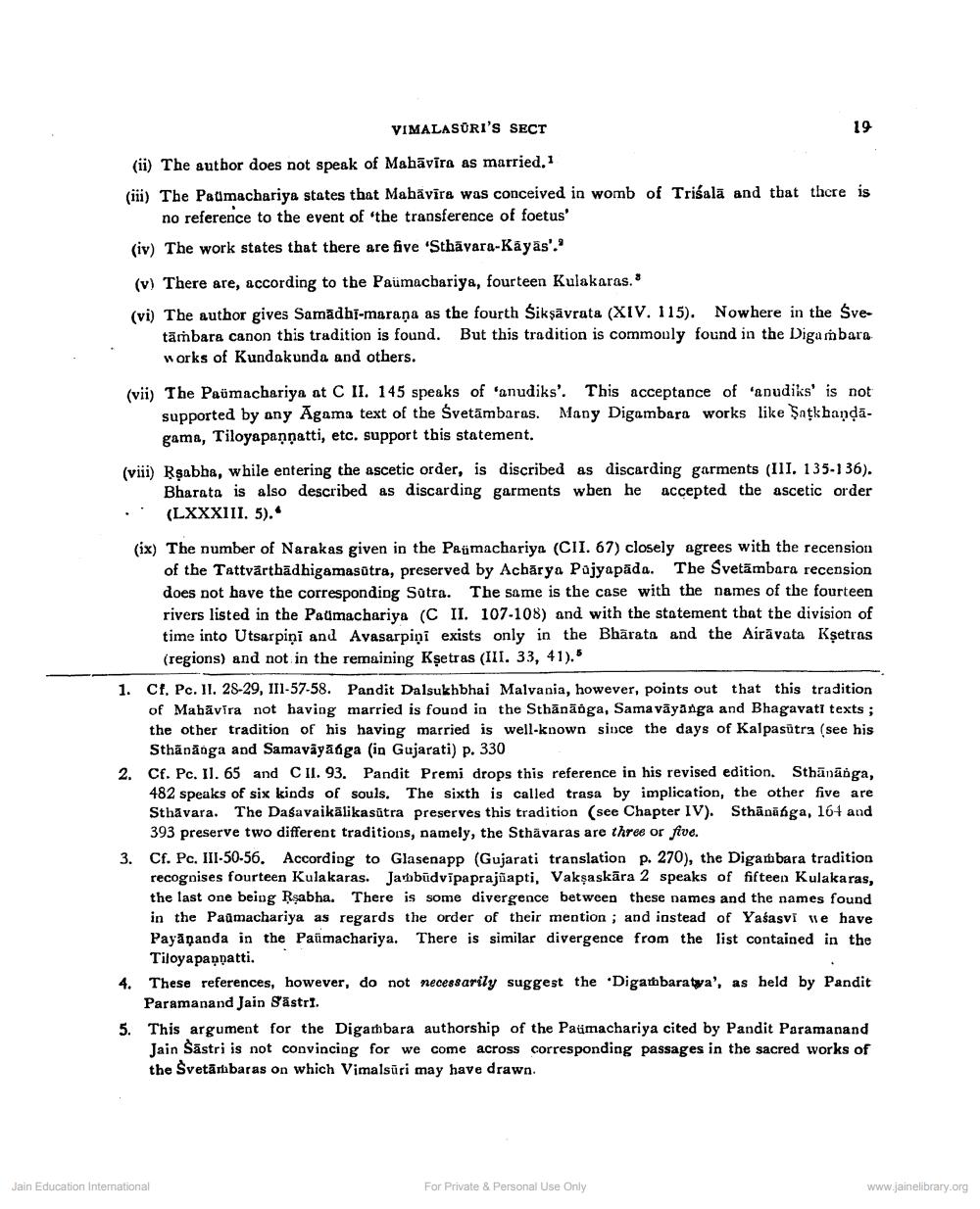________________
VIMALASŪRI'S SECT
(ii) The author does not speak of Mahāvīra as married. 1 (iii) The Padmachariya states that Mahavira was conceived in womb of Trišala and that there is
no reference to the event of the transference of foetus' (iv) The work states that there are five 'Sthāvara-Kayas'.' (v) There are, according to the Paumacbariya, fourteen Kulakaras. (vi) The author gives Samadhi-marana as the fourth Sikşāvrata (XIV. 115). Now here in the Sve
tambara canon this tradition is found. But this tradition is commonly found in the Digambara works of Kundakunda and others.
(vii) The Paümachariya at C II. 145 speaks of 'anudiks'. This acceptance of 'anudiks' is not
supported by any Agama text of the Svetāmbaras. Many Digambara works like Satkhand
gama, Tiloyapannatti, etc. support this statement. (viii) Rşabha, while entering the ascetic order, is discribed as discarding garments (IlI. 135-136).
Bharata is also described as discarding garments wben he accepted the ascetic order .. (LXXXIII. 5).
(ix) The number of Narakas given in the Paimachariya (CII. 67) closely agrees with the recension
of the Tattvärthādhigamasutra, preserved by Acharya Pajyapāda. The Svetämbara recension does not have the corresponding Sätra. The same is the case with the names of the fourteen rivers listed in the Paümachariya (C II. 107-108) and with the statement that the division of time into Utsarpiņi and Avasarpiņi exists only in the Bhārata and the Airāvata Kşetras (regions) and not in the remaining Kşetras (III. 33, 41).
1. Cf, Pc. II. 28-29, 111-57-58. Pandit Dalsukhbhai Malvania, however, points out that this tradition
of Mahavira not having married is found in the Sthānāóga, Sama vāyanga and Bhagavati texts ; the other tradition of his having married is well-known since the days of Kalpasūtra (see his
Sthānanga and Samavāyāága (in Gujarati) p. 330 2. Cf. Pc. II. 65 and C II. 93. Pandit Premi drops this reference in his revised edition. Sthānānga,
482 speaks of six kinds of souls. The sixth is called trasa by implication, the other five are Sthāvara. The Daśavaikālikasūtra preserves this tradition (see Chapter IV). Sthānānga, 16+ and
393 preserve two different traditions, namely, the Sthävaras are three or five. 3. Cf. Pc. III-50-56. According to Glasenapp (Gujarati translation p. 270), the Digambara tradition
recogoises fourteen Kulakaras. Jarbūdvipaprajñapti, Vakşaskāra 2 speaks of fifteen Kulakaras, the last one being Rşabha. There is some divergence between these names and the names found in the Paūmachariya as regards the order of their mention; and instead of Yaśasvi ve have Paya anda in the Paūmachariya. There is similar divergence from the list contained in the Tiloyapannatti. These references, however, do not necessarily suggest the Digambaratya', as held by Pandit
Paramanand Jain Sāstri. 5. This argument for the Digambara authorship of the Paumachariya cited by Pandit Paramanand
Jain Sāstri is not convincing for we come across corresponding passages in the sacred works of the Svetārbaras on which Vimalsūri may have drawn.
Jain Education International
For Private & Personal Use Only
www.jainelibrary.org




